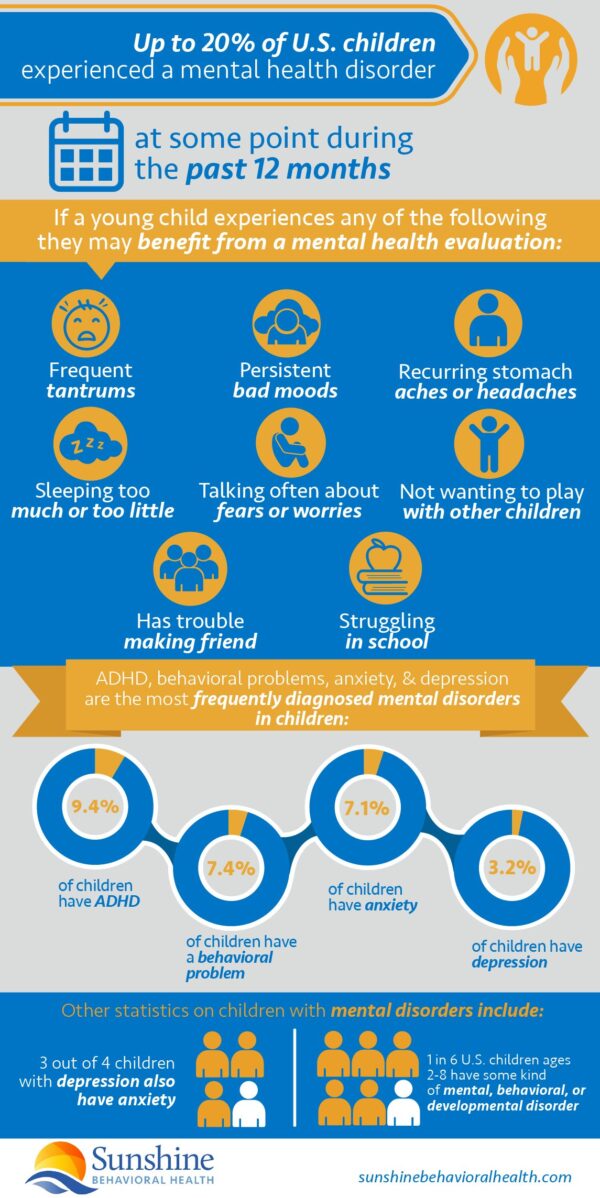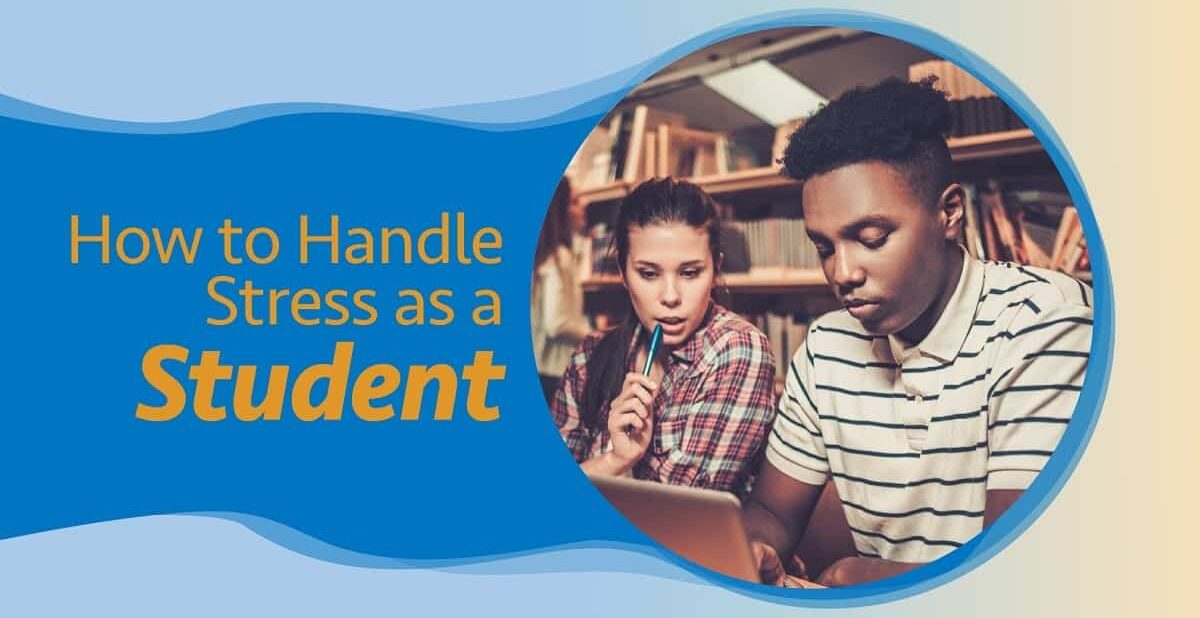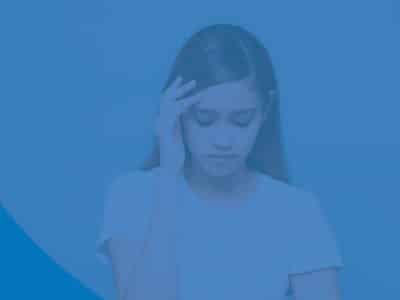Mental health disorders are not uncommon, especially among children.
Attention-deficit/hyperactivity disorder (ADHD), anxiety, behavior problems, and depression are the most frequently diagnosed disorders in children. Nearly 10% — or 6.1 million — of U.S. children have been diagnosed with ADHD, for example. More than 4 million children have anxiety, another 4.5 million have a behavior problem, and nearly 2 million have depression. It’s far from unusual for children to have multiple disorders.
These challenges may cause students to have difficulties in school if unaddressed. Early diagnosis can have a positive impact on children, their families, and the educators and caregivers who work with them daily.
By knowing the symptoms and understanding how prevalent some disorders are, educators can play a critical part in students’ mental health. That knowledge can help them identify problematic behaviors and potential mental disorders, while at the same time promoting mental health and helping ease stigmas.
The Role Educators Can Play
Educators have a unique role in helping students. Not only are they serving as teachers, but they also can act as observers and guides.
By being in regular contact and communication with students, they are schooling them not only in needed skills such as mathematics or reading and writing, but they are also helping their charges develop positive emotional and social skills.
Interacting with and seeing students regularly, educators also may be able to identify when a child or teen might be struggling with a mental health disorder or other challenges. In a climate where counselors and mental health experts are accessible, they may be better able to help get children diagnosed and the assistance they need.
Teachers who create supportive environments and promote positive behaviors also can better reduce stigmas surrounding mental illness. Many disorders, including anxiety, attention-deficit/hyperactivity disorder (ADHD), and depression, often manifest in childhood. Generally, the earlier an individual receives treatment, the better the outcomes tend to be.

Educator Challenges
Despite educators having a key vantage point to help children, they do face some challenges. Several obstacles have been cited, including:
- Poorly defined roles and responsibilities
- Little time to work with mental health experts
- A lack of training and resources
- Crowded classrooms
- Stress and burnout from a lack of support
Compassion is free yet priceless, but it’s not always enough. More knowledge, additional resources, and a greater amount of support can make a powerful difference in a child’s future on an emotional, social, and intellectual level.
When a child is too disruptive, there is a chance they may be expelled from their schools. Even preschoolers face expulsion, often at a higher rate than children in grades kindergarten through 12. Preschool boys and African American children also tend to face higher expulsion rates.
Quality prekindergarten programs leave children better prepared for in-school learning.
Childhood Mental Health Hurdles
It’s estimated that one out of every five children in the United States may have a mental health disorder. Half of all mental disorders manifest before the age of 14. Nearly three-fourths appear by age 18. Close to 20% of students have admitted to contemplating suicide.
Identifying and treating mental health issues at an earlier age tends to produce better outcomes, both in the classroom and beyond.
Mental health problems at a younger age, when not treated, can lead to lower grades and other problems.
Expulsions
In terms of childhood mental health, one thing we know is problems tend to appear early.
Prekindergarten expulsions are almost twice as common — 89% higher — when classrooms lack regular access to a psychiatrist or psychologist. Just 23% of pre-K programs nationwide have on-site mental health professionals or scheduled visits from such workers.
Expelled children risk:
- Lost skill-building and socialization opportunities
- Lowered self-esteem
- A negative view of school
Reasons for expulsions vary: A child’s behavior may prove too much, and adults may decide the child is a danger to himself or herself as well as his or her peers. Teachers may also feel overwhelmed with multiple work responsibilities, receive low wages, or have a large number of children to oversee, making addressing issues more difficult and more challenging.
Not all teachers may understand what lies beneath a child’s behavior, either. Bias (intentional or otherwise) or cultural differences may also factor into how a teacher reacts.
Special Education
Special education students face risks too. The Individuals with Disabilities Education Act (IDEA) offers guidance and oversight on 13 types of disabilities, including autism, learning disabilities, and ADHD. More than 2 million U.S. students have some form of learning disability.
More than 77,000 students with autism, anxiety, or learning disorders are expelled or suspended more than 10 days every school year, which leads to time out of the classroom and potential disruptions to the learning process.
Dropouts
Mental health issues and learning disorders appear linked to higher dropout rates as well. Overall, the dropout rate for U.S. students is 7%, compared to 21.1% of students served by the Individuals with Disabilities Education Act (IDEA).
The dropout rate is even higher among students with emotional issues — 38.7% — per IDEA classification. Nearly 28,000 teens and young adults with autism, ADHD, or emotional disturbances drop out every year.
When individuals drop out of school, they face a higher likelihood of unemployment, underemployment, and prison — all three of which lead to a reduced quality of life. Less education also contributes to a shorter life expectancy.
Common Mental Health Problems
It’s estimated that 49.4% of children with some form of mental health disorder have not received treatment or counseling. That number varies, depending on the disorder and the place where a child resides — nearly 30% in Washington, D.C., to 72.2% in North Carolina, for example.
There are several mental health issues students may experience, including depression, anxiety, post-traumatic stress disorder (PTSD), phobias, and substance use disorders. For a student juggling academic work, growing pains, chores, extracurricular activities, and more, a mental health problem carries an added burden. It can affect their grades, their health, and more.
Such disorders are far from rare, however, and with earlier diagnosis and treatment, a student’s quality of life can improve dramatically.
Depression
Nearly 2 million U.S. children have been diagnosed with depression. Many more may have the condition but remain undiagnosed.
Common symptoms of depression include:
- Sadness
- Lack of interest in doing things
- Feelings of worthlessness
- Guilt
- Sleep troubles
- Eating too much or too little
- Tiredness
- Trouble concentrating
- Unexplained aches and pains
Treatment may include talk therapies and antidepressants.
Anxiety
Anxiety can take on many forms.
- Generalized anxiety disorder (GAD) is the most common kind of anxiety disorder and is characterized by excessive worry and high levels of stress. It usually is diagnosed if the issue occurs for at least six months. It can be tied to activities, events, friendships, or in anticipation of things like a test or a gym class. A child suffering GAD may have trouble sleeping, feel irritation or fatigue, or experience muscle tension.
- Separation anxiety disorder. To some extent, this is normal among very young children, usually around toddler age. An older child who is terrified of being separated from a parent or a caregiver, or who fights going to school or a sleepover, and develops headaches or stomachaches or other symptoms as a result of anxiety may be diagnosed with this disorder.
- Selective mutism. These children often are chatty in situations where they feel comfortable, but they might be silent, avoid eye contact, or act withdrawn at other times.
- Phobias. Here, a child may be extremely afraid or anxious about certain objects or situations. Whatever the trigger is, they may panic, cry, cling to an adult, or become paralyzed with fear at the sight or prospect of it.
- Panic disorder. Panic attacks — characterized by hyperventilating, dizziness, chest pain, or a fear of dying — are key symptoms.
- Social anxiety disorder. Children with this disorder may cry, scream, throw tantrums, refuse to speak, and try to avoid the triggering social situation. They may fear going to school or certain social situations.
When treating an anxiety disorder, it’s wise to receive an assessment first, to be certain what the issue may be. From there, talk therapy and medication (or a combination thereof) are typically the main courses of treatment.
Obsessive-Compulsive Disorder
Obsessive-compulsive disorder (OCD) is usually marked by obsessions or compulsions:
- An obsession manifests as unwanted thoughts that take over one’s thinking.
- A compulsion is when someone cannot stop doing a certain action or ritual.
Children with OCD may have persistent worries, repetitive actions, habits that get in the way of everyday life, and urges to hoard, and they may constantly seek reassurance. Excessive hand-washing or constantly arranging or lining up items are two ways OCD can manifest.
It’s estimated to affect about 1% of school-aged children. Causes vary, but often a major life event or something extremely stressful (such as a divorce or the death of a loved one) can spark OCD.
Exposure and response prevention (ERP) therapy or a combination of ERP and medications are often effective OCD treatments.
Post-Traumatic Stress Disorder (PTSD)
Post-traumatic stress disorder, or PTSD, can result after any traumatic event. It can be sexual or emotional abuse, violence, a natural disaster, an accident, or something else that sends a person’s world into upheaval and leaves them feeling violated or unsafe. They may relive the event in their heads, avoid triggers, and experience anxiety or trouble sleeping, among other issues.
Psychotherapies, mindfulness activities, and medications can be helpful in managing PTSD.
Bipolar Disorder
A person with bipolar disorder (formerly called manic-depressive disorder) will vacillate between extreme highs (mania) and lows (depression). The manic phases are often characterized by wakefulness, risky behaviors, and racing thoughts. The depressive side of the disorder includes symptoms of depression, but with more intense lows.
Medications, counseling, and some lifestyle changes (such as creating routines) can make the condition more manageable.
Substance Use Disorder
Substance use disorders are especially risky for younger populations, in part because their brains are still developing. Drugs and alcohol meddle with brain functioning at any age, eventually altering how it works.
Because the brain still is forming into a person’s early to mid-twenties, decision-making and impulse control areas are not fully matured, and drugs and alcohol can have a more devastating effect as a result, leaving more lasting damage. One of the larger risk factors for addiction is drug or alcohol use at an early age.
Misusing drugs and alcohol can also make a person more prone to developing many mental disorders, including depression, anxiety, or bipolar disorder. Conversely, many mental disorders can make an individual more likely to resort to drug or alcohol use as a form of self-medication. (That’s called a dual diagnosis or co-occurring disorder. Either condition can fuel the other.)
Signs of a substance use disorder include:
- Behavioral changes such as poor school attendance, fights, mood swings, or paranoid actions
- Physical changes such as bloodshot eyes, slurred speech, impaired coordination, or sudden weight fluctuations
- Social changes such as new friends and hangouts, legal problems, and financial issues
Addiction carries several other risks too. It can lead to dangerous behaviors such as unsafe sex, reckless driving, unplanned pregnancies, sexually transmitted diseases, and accidental overdoses. Over time, addiction can raise the likelihood of many diseases (heart, liver) and many cancers.
Abstinence from alcohol and drugs is the safest bet to prevent substance use disorders, but if a person has a dependence on drugs or alcohol, then counseling, medications, and rehab are treatment options.
Signs of a Problem
Drastic changes in behavior are common signs that a child or teen may be struggling with some sort of mental health or personal issue. Symptoms of a problem include:
- Sad or withdrawn behavior
- Panic attacks, wild fears
- Discussion of or attempts at self-harm
- Fights or behavior that could harm the student or others
- Theft or other destructive behavior
- Troubles concentrating or focusing
- Failure to complete schoolwork
- Poor attendance
- Frequent sick days or visits to the nurse
- Hyperactivity or jittery actions
- Sleepiness
- Mood swings
Knowing the potential signs of a mental health struggle or substance use disorder is a crucial first step in identifying a possible problem. One student may be sleeping in class because they’re suffering from anxiety and can’t sleep well at night, while another may be nodding off because they’re hungover. Each case is unique. What’s common is that there is something afoot.
Educating others, including students, staff, and parents on the signs can be helpful tools. Knowledge and compassion can help erase the stigma. Promoting positivity and an encouraging environment can make a difference too.
Causes of Mental Illness
Understanding potential causes of mental disorders can also be helpful. There is no one clear cause of mental illness. Instead, there are many potential culprits, including a combination of contributing factors:
- Abuse, trauma, or neglect
- Socially isolation or loneliness
- Trauma or loss: This can result from an accident, bullying or abuse, or the death of a loved one
- Stress, especially when it’s severe or ongoing
- A lingering physical health condition
- Drug or alcohol abuse
Sometimes mental illness runs in families. That doesn’t mean a parent with depression or schizophrenia guarantees their offspring will have the condition, but it can raise the likelihood.
Helping Students with Mental Illness
If educators have determined that a student is exhibiting warning signs for a mental health issue, it’s a good idea to consult with the school psychiatrist, principal, nurse, or counselor/social worker to ensure that the student receives the help they need.
Offering educational programs that help identify mental health issues; providing a positive and safe learning space, promoting social and emotional competencies, and reinforcing positive behaviors can make a difference in a child’s or teen’s life.
When discussing mental health with students, offering outlets is key. These hotlines may be helpful for students, parents, and educators alike.
Crisis numbers and mental health resources:
- National Suicide Prevention Lifeline: This network of local crisis centers provides free and confidential emotional help to people in crisis 24 hours a day and seven days a week. 800a273a8255
- National Youth Crisis Hotline: 800a448a4663. This line is open 24 hours for any kind of youth crisis. Hearing impaired youths can call 800a448a1833.
- Substance Use Disorder and Mental Health Services Administration (SAMHSA): 800a662aHELP (4357). This federal clearinghouse of information offers free, confidential, around-the-clock information for anyone with a mental health crisis or a substance use disorder.
- National Alliance on Mentally Illness (NAMI): 800a950aNAMI (6264). NAMI is staffed by peers and callers can find answers to mental health questions, including resources and referrals.
- The Trevor Project:866a488a7386 or text START to 678a678. This national organization helps lesbian, gay, bisexual, transgender, queer and questioning (LGBTQ) youth (under age 25) by providing crisis intervention and suicide prevention services.
- Teen Line: 310a855aHOPE (4673) or 800aTLCaTEEN (852a8336) or text TEEN to 839863. This nonprofit organization provides peer support. It can help with specific problems or just be there to offer a sympathetic ear.
Other resources:
- Head Start: Overseen by the U.S. Department of Health & Human Services, Head Start services provide a number of resources and articles on mental health, both for children and caregivers.
- IDEA: Individuals with Disabilities Education Act: The U.S. Department of Education and the Individuals with Disabilities Education Act provide information and resources for parents, students, educators, and service providers seeking help for children with disabilities.
- MentalHealth.gov: This federal site has information for educators, including warning signs, crisis support, mental health services, tips for developing programs, and more.
Sources
Medical disclaimer:
Sunshine Behavioral Health strives to help people who are facing substance abuse, addiction, mental health disorders, or a combination of these conditions. It does this by providing compassionate care and evidence-based content that addresses health, treatment, and recovery.
Licensed medical professionals review material we publish on our site. The material is not a substitute for qualified medical diagnoses, treatment, or advice. It should not be used to replace the suggestions of your personal physician or other health care professionals.






